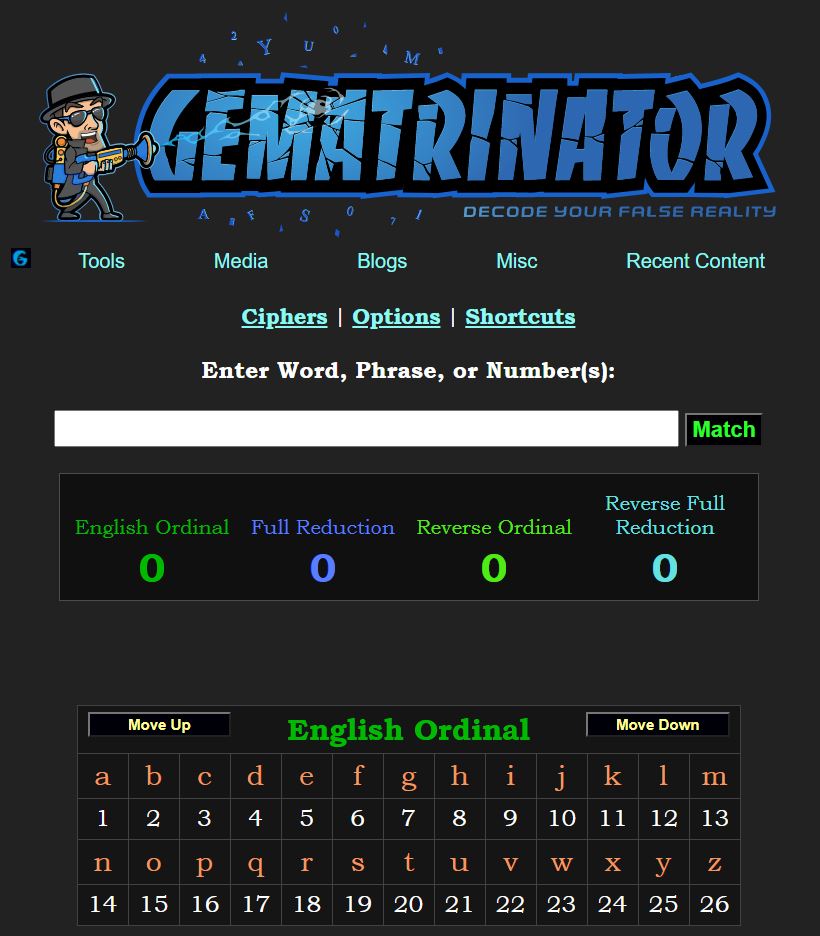If you’ve read my first post about the importance of Gematria, you should be ready for the next step. In this short article, we will look at the four common English ciphers – the ones that are used most today.
Albert Pike, one of the most renowned Freemasons within the Scottish Rite of Freemasonry, mentions in his book ‘Morals and Dogma’, once considered the bible of Freemasonry, that there are “ten ciphers.” He was referring to the ancient Gematria practices in Hebrew, which has a 22-letter alphabet, same as the ancient Phoenician alphabet, the world’s first, that Hebrew is based upon, same as English. It is important to understand that there is more than one way and one cipher to decode a word from letters into numbers, and that each cipher is interrelated with a fluid consistency. Gematria is simply geometry within language – a practice as old as language itself.
Once you start exploring multiple ciphers you will discover connection between certain words and certain ciphers. You will discover how some words has a connection and a similar meaning, while their opposites usually have opposite numbers. For example, ‘Paradise’ in ordinal is 73, while ‘Hell’ is 37. The opposite, or a reflection. Other important words that represents duality and lies usually have this reflection within themselves, as for example ‘Hell’, which is 71 in Reverse Ordinal and 17 in Reverse Full Reduction.
The four standard English ciphers are:
English Ordinal
Full Reduction
Reverse Ordinal
Reverse Full Reduction
English Ordinal
Ordinal means the alphabetic order; thus, the first letter is worth 1, the second is worth 2, and the last 26th is worth 26. That is, A=1, B=2, C=3, and so on until Z=26.

English Reverse Ordinal
Reverse Ordinal simply means that Z is worth 1, Y is worth 2, and so on until A that is worth 26. It’s simply assigning the numeric values backwards, as in “reverse”.

English Full Reduction
Full Reduction, or ‘Pythagorean Gematria’, or ‘English Reduced’ goes back to Pythagoras, the Greek father of mathematics, who believed the only true numbers were 1 through 9. That means that the 10th letter, J, becomes 1 because 1+0 is 1. K becomes 2 as 1+1 is 2 and so on up to R=9. As S is 19, it is seen as 1+9 = 10, which is 1, so S=1 and so it goes to Z=8.

English Reverse Full Reduction
And Reverse Full Reduction is simply assigning the values 1 to 9 but in reverse. Z is 1up to R that is 9, Q is again 1 up to I that is 9, and finally H is 1 and A is 8.

So, in essence we have the Ordinal cipher with 1 up to 26, which can be reversed. And then the Full Reduction (Pythagorean) that goes from 1 to 9 and the repeats throughout the alphabet, and you can do it in reverse. That’s all there is to it for the four most common ciphers!
Let’s do a quick decode of Pike’s Morals and Dogma and why he titled the book as he did.
Washington D.C. is not only the head office of the United States federal government, but also the headquarters of the Scottish Rite of Freemasonry for all of North America.
Morals and Dogma = 137 (English Ordinal)

Washington D.C. = 137 (English Ordinal)


The cornerstone of Washington D.C. was laid on September 18, 1793.
9/18/1793 = 9+18+17+93 = 137
The Freemasonic compass has an upper degree of 47 and a lower of 90.
47+90 = 137
137 is also the 33rd Prime Number and the highest “master teacher” ranking within Scottish Rite of Freemasonry.
Also note that the building has 33-exterior pillars, each standing exactly 33-feet tall…


Also note that both ‘Morals and Dogma’ and ‘Washington D.C.’ equals 56 in Full Reduction, strengthening their connection.
Gematrinator can be found at: http://www.gematrinator.com/calculator/
